On this small sheet, forms are created by broad areas of wash, free from the solid outlines of earlier drawings. Degas' use of thinned paint expanded the creative possibilities of brushwork and color; for instance, the figure's left arm is formed by the negative space between two areas of wash. This is one of several studies made by the artist in preparation for the female figure in Interior (Philadelphia Museum of Art). The ambiguous, tense nocturnal scene in the painting is evocative of contemporary novels, such as Thérèse Raquin, émile Zola's chronicle of lust and murder. The subject's internal, private focus is emphasized by her oblique position and vague features.
Plan your visit. 225 Madison Avenue at 36th Street, New York, NY 10016.
Plan your visit. 225 Madison Avenue at 36th Street, New York, NY 10016.
Degas: Drawings and Sketchbooks
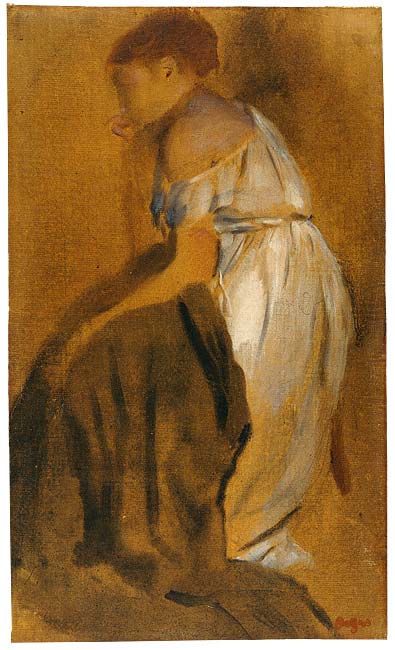
Study of a Seated Woman, 1868–69
Stamped in red ink at lower right, Degas; inscribed at right with extraneous numbers.
Bequest of John S. Thacher, 1985
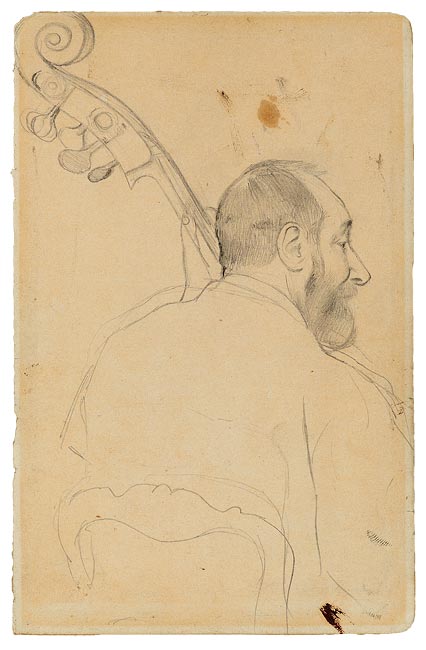
Achille Henri Victor Gouffé (1804–1874), Double Bass Player at the Paris Opéra, 1869
Thaw Collection
Degas masterfully employed the device of placing the cropped figure of the bass player Gouffé—seen from behind—in the extreme foreground of the painting The Orchestra of the Opera (Musée d'Orsay, Paris). The viewer is situated in the audience, directly behind the orchestra pit, with a view past Gouffé to the footlit stage.
X-radiographs of the painting reveal that the figure of Gouffé was added at a late stage of execution, explaining the need for the present study. In fact, this sheet is from a sketchbook Degas used in Paris and Normandy between 1869 and 1872 that contained two other drawings for the same painting. These studies reveal his complex working method and document the continued evolution of the composition.
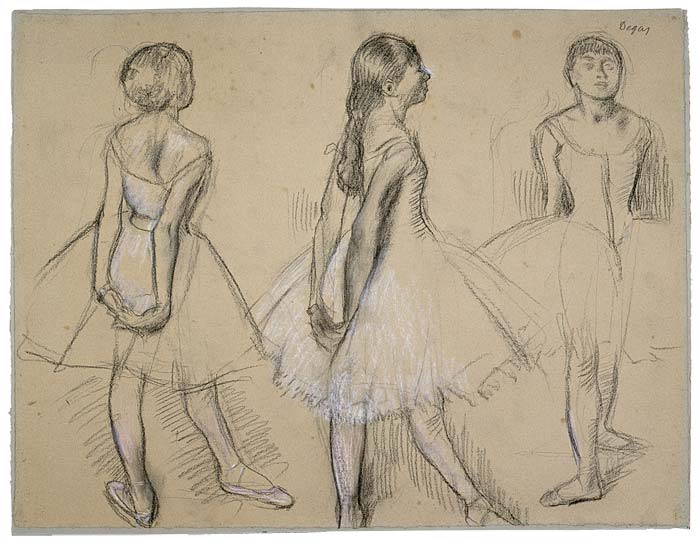
Three Studies of a Dancer
Signed in black pastel at upper right corner, Degas
Gift of The International Music & Art Foundation
One of Degas' principal concerns as a draftsman was analyzing the movements and gestures of the female body. The three studies on this sheet depict the teenage dancer Marie van Goethem and were produced in preparation for the celebrated wax sculpture Little Dancer, Fourteen Years Old. The sculpture was briefly exhibited at the 1881 Salon, where the artist's inclusion of a wig and a fabric bodice and skirt caused a sensation.
Degas made numerous studies of Marie between 1878 and 1880. Here the artist studied her from three different angles, attempting to understand the figure in the round in preparation for sculpting it. As the chalk strokes show, her foreshortened left foot posed a problem when seen from behind, as did her bent arms in profile.
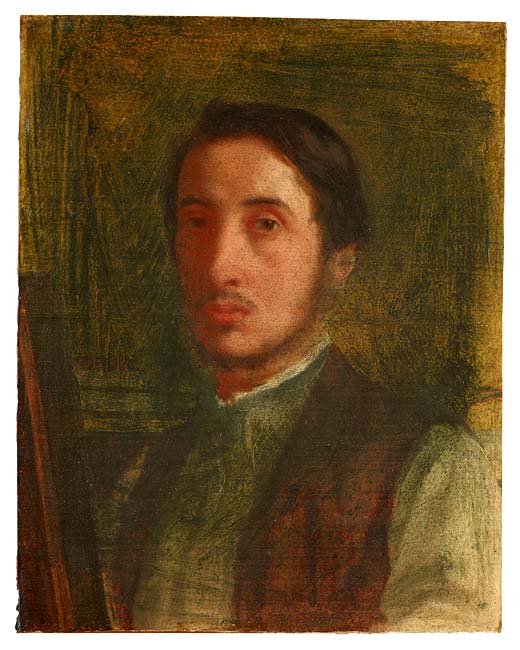
Self-Portrait in a Brown Vest, 1856
Bequest of John S. Thacher, 1985
This small-scale, somewhat tentative exploration in oils reveals Degas' continued use of himself as subject as he came to grasp the rudiments of portraiture. Here he posed with the right half of his body lost in shadow and with a cautious and reserved gaze—as opposed to contemporaneous portraits that depict a more assertive and arrogant young man. This foray into sketching with oil paint was likely executed shortly before the artist left for Italy.
Such familiar subject matter is typical not only of Degas' early years but of his entire career: he very rarely accepted commissions and often found subjects within his social milieu, hired models, or working-class entertainers.
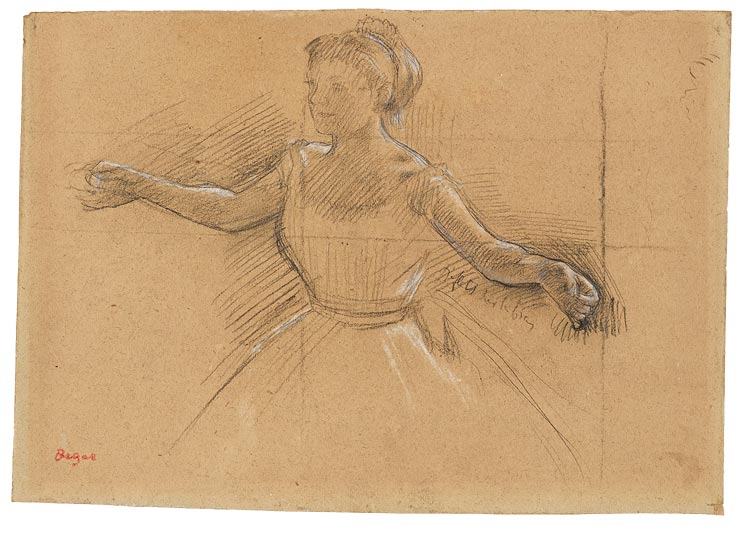
Dancer with Arms Outstretched, ca. 1878
Inscribed by the artist below the left arm, reflets sur le bras
Thaw Collection,The Morgan Library & Museum
By the late 1870s, Degas had become increasingly absorbed by the behind-the-scenes activities at the ballet. This study of a dancer in second position is for a ballerina in The Rehearsal (1878–79; Frick Collection, New York), which shows dancers practicing with a violinist in the rehearsal studio. Both the Frick painting and the present drawing were in the collection of Degas' lifelong friend, the industrialist and Impressionist supporter Henri Rouart (1833–1912).
Degas' note about the reflections on the dancer's arm attests to his focus on how light defines the girl's body; the squared grid indicates that Degas transferred the figure to another support while working on his canvas.
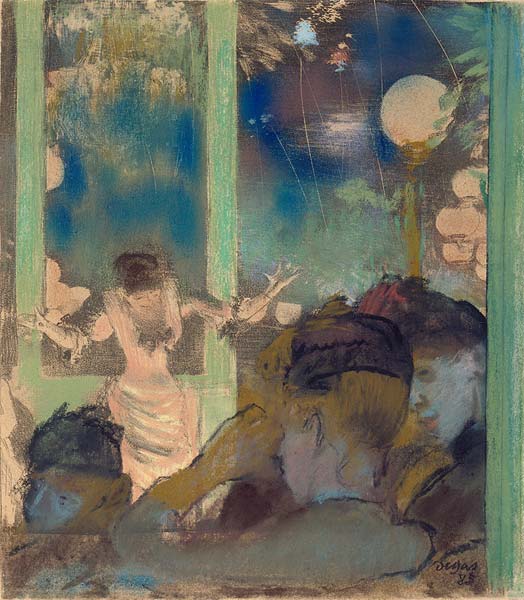
Mademoiselle Bécat at the Café des Ambassadeurs, 1877/85
Signed and dated at lower right, in pastel, Degas / 85.
Thaw Collection
This vivid scene of a performance by the famed chanteuse Emilie Bécat at the Café des Ambassadeurs captures the spectacle and excitement of the outdoor café-concert in fin-de-siècle Paris. Degas was a frequent visitor to this popular and coarse form of entertainment for a brief period during the late 1870s and used it as inspiration for compositions, such as this 1877 lithograph that he reworked in pastel nearly a decade later. The three silhouetted female spectators in the immediate foreground—added entirely in pastel to the underlying print—contrast with the spotlighted singer, who is performing her frenzied, comic dance, with arms raised and fingers splayed, in her trademark style épileptique.
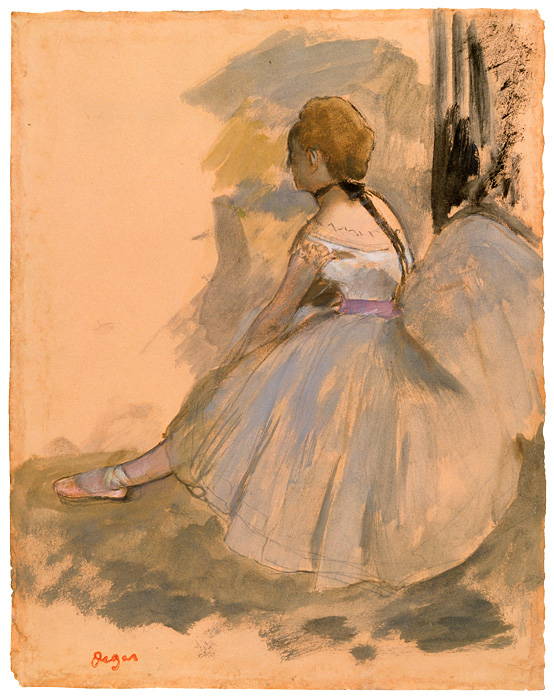
Seated Dancer, ca. 1871
Stamped at lower left corner, Degas
Thaw Collection
Using dark washes of thinned oil paint to throw the figure into relief, Degas expertly retained the paper's tone to highlight the dancer's back. This sheet is one of five surviving studies related to the artist's 1872 canvas Dance Class at the Opéra on the Rue le Peletier (Musée d'Orsay, Paris). Typical of Degas' dynamic working method, the figure does not exactly correspond to the final painting, in which her face is seen in full profile and her torso is turned toward the left.
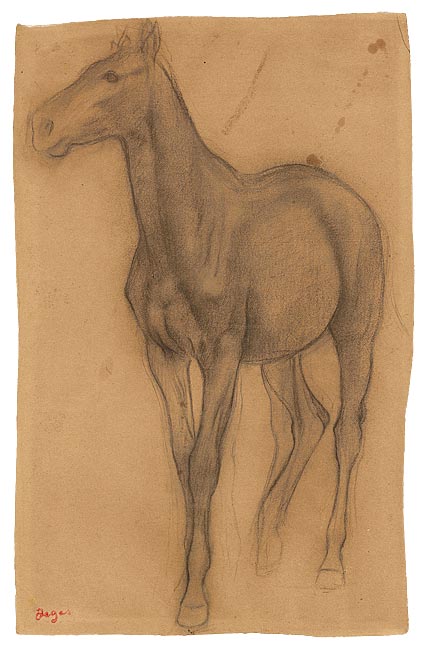
Racehorse, 1878
Stamped at lower left corner, in red, Degas
Thaw Collection
This richly worked study was produced in 1878, when Degas chose to revisit an earlier composition (see the sheet Four Jockeys) for a new painting depicting jockeys gathering by the starting pole. He delineated the horse's form, smearing the charcoal to model the thoroughbred's muscular body. Degas' interest in horses and racetrack scenes is evident throughout his career. In fact, for his earliest forays into sculpture in the 1860s, he chose the horse as his subject, a decade before étienne-Jules Marey's or Eadweard Muybridge's famed photographs of horses in motion.
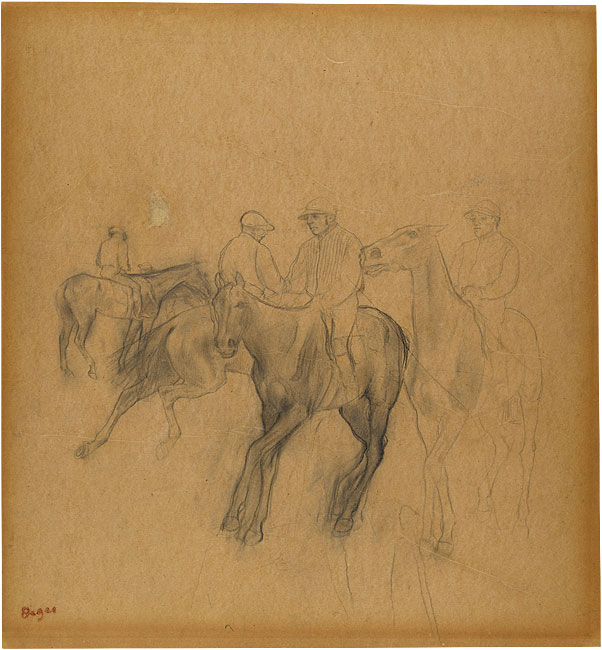
Four Jockeys on Horseback, ca. 1868, reworked ca. 1878
Stamped at lower left in red ink, Degas.
Thaw Collection
This sheet provides an exceptional example of how Degas worked, reworked, and revised a particular scene over a span of years. Drawn on tracing paper, these studies were originally made in 1868 in connection with the painting Racecourse Scene (Weil Brothers-Cotton Inc., Montgomery, Alabama). Degas revisited the composition—and this sheet—a decade later in preparation for the painting Jockeys Before the Start (Barber Institute of Fine Arts, Birmingham, England). In reworking the composition, he focused his attention, and his pencil, on the horse and rider at center, which are prominent in the Birmingham painting.
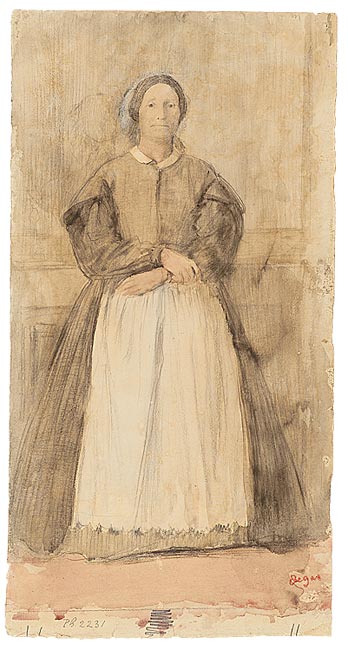
Rosa Adelaide Aurora Degas, the Duchess Morbilli, ca. 1858
Thaw Collection
Degas' grandfather fled the revolution in France and settled in Naples, though his eldest son—Degas' father—would later return to Paris. The artist's Neapolitan relatives appear in numerous painted and drawn portraits that were executed while he was in Italy.
Rosa (1805–1879), the eldest sister of Degas' father, married Giuseppe Morbilli, Duca di S. Angelo a Frosolone, who died in 1842, leaving her with seven children to support. Her eldest son, Gustavo, died during the 1848 revolution in Italy. This early watercolor—a technique Degas rarely used—was likely executed about 1858 in Naples. The intelligent countenance of the artist's fifty-three-year-old aunt renders her among his most compelling familial subjects.
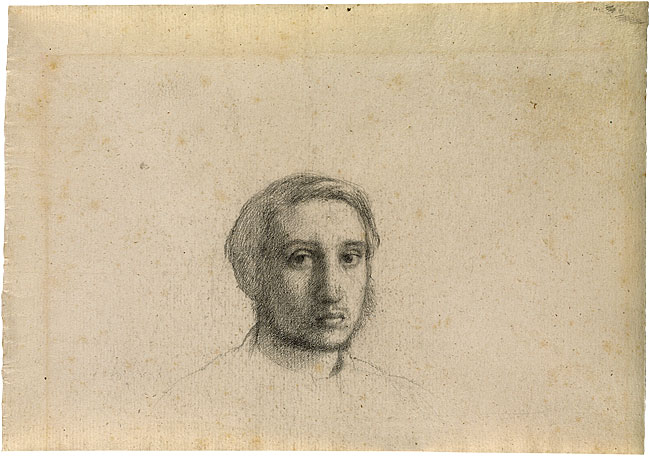
Self-Portrait
Thaw Collection
A series of self-portraits, drawn and painted, emerged from Degas' youthful period, before 1859. This study was a private exercise in proficiency and discipline and remained in portfolios in Degas' studio until his death.
In the Renaissance manner, Degas explored his visage using light and shadow to model form, deftly achieving subtle effects with fine black chalk. Executed on a half sheet of French paper, this study may have been undertaken just prior to or shortly after his arrival in Rome.
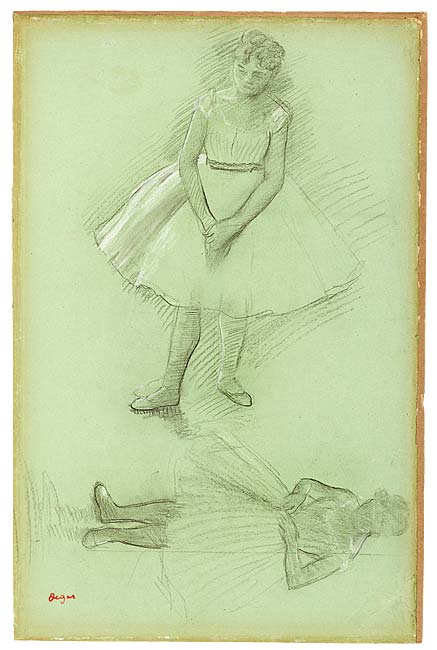
Two Studies of Dancers, ca. 1873
Thaw Collection
The principal figure on this sheet appears in two versions of the painting The Rehearsal (Harvard University Art Museums and Shelburne Museum, Vermont). The secondary figure on the sheet, with her hands adjusting the ties on her skirt, was used for the Harvard canvas only.
Degas often made multiple studies on a page, in this case turning the sheet ninety degrees to produce a separate study. He selected vividly colored papers for studies in black and white chalks. The middle tone of the paper allowed him to maximize their tonal range. The summary description of the faces reveals the artist's greater interest in determining how light from the rehearsal studio windows would illumine the figures.
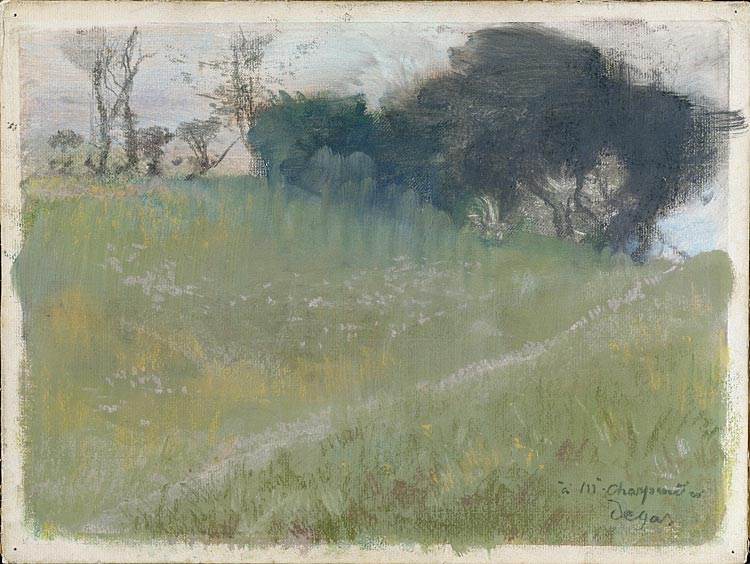
Landscape with Path Leading to a Copse of Trees, ca. 1890–92
Signed and inscribed at lower right in charcoal, á M. Charpentier / Degas.
Thaw Collection
In the early 1890s, when Degas' work became increasingly less naturalistic, he produced a series of pure landscapes that freely interpret the scenery he encountered on his way to visit the painter and printmaker Georges Jeanniot in the village of Diénay, near Dijon. There Degas produced about fifty monotypes, which he enhanced with vivid pastel work. The group was shown by Durand-Ruel in Paris in 1892.
For the present monotype, Degas prepared a metal plate with a layer of thinned salmon-colored oil paint and roughly indicated elements of the landscape with a brush. He ran the plate through a press, producing a print. He completed the print with vigorous strokes of paint and an extensive layer of wet and dry pastel to achieve exceptionally atmospheric results.
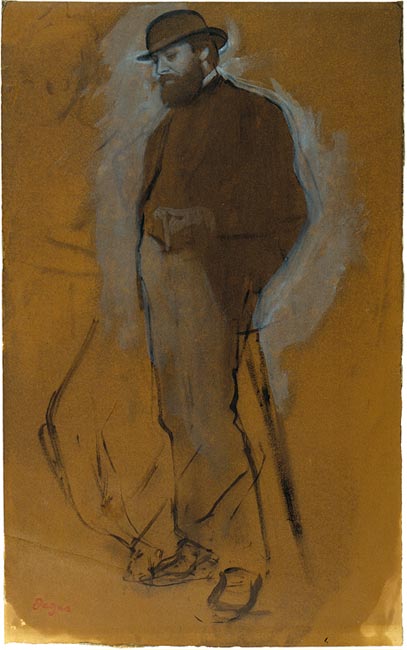
Standing Man in a Bowler Hat, ca. 1870
Stamped in red ink at lower left corner, Degas.
Bequest of John S. Thacher
This study of a well-dressed flaneur is similar to Degas' depictions of his urbane and fashionable brother Achille in Paris in the years prior to the artist's 1872 departure for New Orleans. It may have been executed about the same time that Degas prepared A Cotton Office: this bearded gentleman is perhaps an unused stock figure for the finished composition. The purpose of the odd, angular outlines in the lower half of the sheet is unknown.
